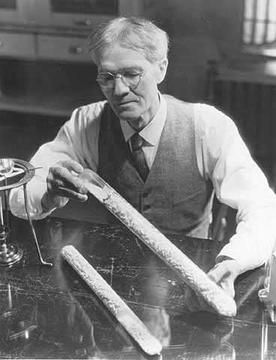Alexander P. Anderson facts for kids
Alexander Pierce Anderson (born November 23, 1862 – died May 7, 1943) was an amazing American scientist and inventor. He studied plants and taught others. His cool science experiments led to the invention of "puffed rice". This was the start of a new breakfast cereal. It was even advertised as "Food Shot From Guns" because of how it was made!
Contents
Who Was Alexander Anderson?
His Early Life and Schooling
Alexander Anderson was born in Featherstone Township, Goodhue County, Minnesota. His parents, John and Britta Anderson, were immigrants from Sweden. He grew up on a farm near Red Wing, Minnesota. At first, it seemed like he would become a farmer too.
But at age 27, he decided to go to college. In 1890, he started studying agriculture at the University of Minnesota. While still a student, he invented a "self-registering balance." This was a special weighing machine. A company called Bausch & Lomb Optical Company even bought his invention!
His teachers encouraged him to keep learning. He earned a master's degree in plant physiology in 1897. This is the study of how plants work. He then traveled to Munich, Germany, in 1895. He studied with top plant scientists there. He earned his doctorate degree from the University of Munich. His cousin, John Lind, who later became a governor, helped him pay for his trip.
How He Invented Puffed Rice
After finishing his studies, Anderson taught at Clemson Agricultural College in South Carolina. This was from 1896 to 1899. In 1901, he became a curator at Columbia University. This allowed him to do research at the New York Botanical Garden.
He had a scientific idea: he thought there was a tiny bit of water inside every starch crystal. To prove it, he did an experiment in December 1901. He put starch grains in a sealed glass tube. Then he heated them until they started to brown.
Anderson believed the water inside each grain would turn into steam. He thought if he broke the tube, the steam would burst out. So, he smashed the glass tube. What happened next was amazing! The explosion created a stick of pure puffed starch. This new breakfast food would make him famous. He even became the face of a Quaker Oats advertising campaign!
Anderson needed help to turn his idea into a product. He met with businessmen in Minneapolis. They gave him a lab to try out his ideas. He used a big gas pipe, about four feet long. He sealed it at both ends, with one end that could be removed. He put raw rice inside and heated it while turning the pipe.
When the pressure was just right, he used a sledgehammer to knock off the removable end. A shower of puffed rice burst out! The businessmen were interested. But they sold their shares to Quaker Oats Company. Quaker Oats gave Anderson a lab in Chicago.
Becoming Famous at the World's Fair
Anderson finally got a lot of attention at the 1904 St. Louis World's Fair. He brought eight bronze cylinders. They looked like small cannons! Each "cannon" held six pounds of raw rice. He heated them up. When he opened them, a huge cloud of expanded rice burst out. It showered into a giant cage, two stories high and forty feet wide!
Helpers bagged the puffed rice. They sold it for just a nickel to excited people watching. By the end of the fair, Anderson's team had puffed over 20,000 pounds of rice! They sold a quarter-million packages.
He received patents for his puffing process. In 1905, he started the Anderson Puffed Rice Company. American Cereal, a part of Quaker Oats, sold his new product as "Puffed Rice" cereal. Two years later, Quaker Oats took over making it.
Anderson worked with Quaker Oats to create puffed rice and wheat products. This included a cereal called Quaker Crackels. Quaker Oats advertised puffed cereal as "Prof. Anderson's Gift." They even called Puffed Wheat "The Eighth Wonder of the World"! Later, puffed grains were famously nicknamed "Food Shot From Guns."
Later Life and Legacy
Alexander Anderson married Lydia McDougall Johnson in 1898. They moved to the Red Wing area in 1915. Anderson built a laboratory on their farm, called Tower View Farm. They raised four children while he continued his research.
He also bought more land and supported charities. He helped the Vasa Children's Home and set up scholarships for students. His company, Anderson Puffed Rice Company, stayed in business until 1941. During his career, Anderson did over 15,000 experiments! He earned 25 United States patents and many foreign patents for his cereal inventions. He passed away in 1943 at the age of 80.
One of Anderson's children, John Pierce Anderson, married Eugenie (Anderson) Moore. She was a very important person. President Harry S Truman appointed her as the Ambassador to Denmark. She was the first woman in American history to be appointed as an ambassador!
The Anderson Center Today
The old Tower View Farm is now a special place called the Anderson Center. It was added to the National Register of Historic Places in 1977. Today, it hosts a program for artists, writers, and scholars. They can live and work there. The A. P. Anderson award is given out every year by the Anderson Center. It honors people who have made big contributions to art and culture in Minnesota.


